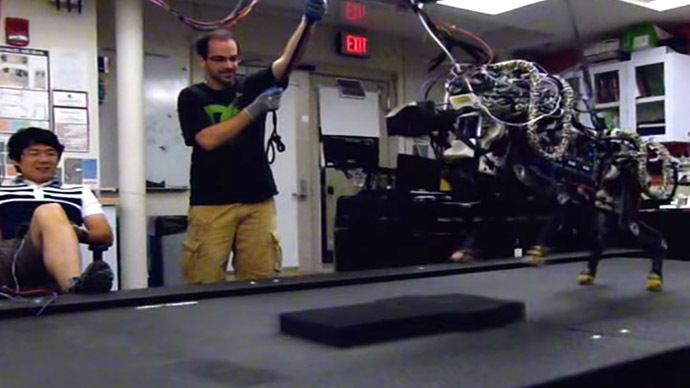Funded by the Pentagon’s research arm, a robot inspired by the world's fastest animal is being developed to run and jump with unprecedented robotic balance and instincts, all with the aim of using it in hostile environments or search and rescue missions.
The robot cheetah has evolved, thanks to researchers at the Massachusetts Institute of Technology (MIT), after five years of rigorous testing and ingenuitive uses of existing technology.
MIT’s cheetah - which runs on batteries to achieve speeds over 10 miles per hour (mph), jumps as high as 16 inches gallops of at least 15 minutes - runs on 12 lightweight motors supplied with electric power and uses an algorithm that decides the precise amount of force a leg should exert while maneuvering. An internal computer sifts the data from the robot’s many sensors and then commands the motors in accordance.
"This is kind of a Ferrari in the robotics world, like, we have to put all the expensive components and make it really that instinctive," Sangbae Kim, MIT professor and leader of the school’s Biomimetic Robotics Lab, told AP. "That's the only way to get that speed."

Kim said the robot cheetah was developed using designs of other technologies, from all-terrain wheelchairs and vehicles that can traverse rough ground to Xbox controllers used for maneuvering. He said the researchers hope the 70-pound cheetah will eventually be able to execute search and rescue missions or enter environments that humans cannot.
"In the next 10 years, our goal is we are trying to make this robot to save a life," Kim said.
Each cheetah leg is powered by three motors that, AP reported, can generate much force even at low speeds.
"When the robot is running, at every step, we calculate the appropriate amount of the force to the legs so that the robot can balance itself," said MIT research scientist Hae-Won Park, writer of the cheetah’s movement algorithm.
Researchers hope continued improvement on the current model, including additional sensors, will mean the robot can eventually move autonomously.
The MIT robot is reminiscent of similar projects developed by Boston Dynamics, including another “cheetah” that has hit running speeds of over 28 mph on a treadmill while connected to a power source. Boston Dynamics also has an untethered quadrupedal robot, WildCat, that has run as fast as 16 mph.
The MIT and Boston Dynamics robots are all funded by the US Department of Defense’s research affiliate, the Defense Advanced Research Projects Agency, or DARPA.


